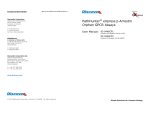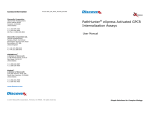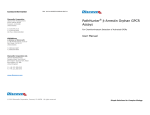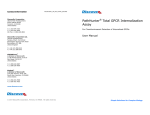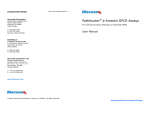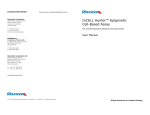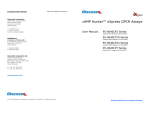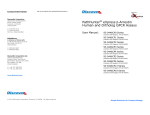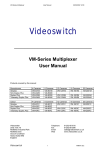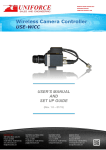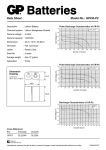Download PathHunter® eXpress β-Arrestin Orphan GPCR Assays
Transcript
Contact Information 70-256 DRx_UM_PHeX_ORPHAN_0914V6 DiscoveRx Corporation (World Wide Headquarters) 42501 Albrae Street Fremont, CA 94538 United States PathHunter® eXpress β-Arrestin Orphan GPCR Assays t | 1.510.979.1415 f | 1.510.979.1650 toll-free | 1.866.448.4864 User Manual DiscoveRx Corporation Ltd. (Europe Headquarters) Faraday Wharf, Holt Street Birmingham Science Park Aston Birmingham, B7 4BB United Kingdom t | +44.121.260.6142 f | +44.121.260.6143 KINOMEscan® A division of DiscoveRx 11180 Roselle Street, Suite D San Diego, CA 92121 United States t | 1.800.644.5687 f | 1.858.630.4600 BioSeek® A division of DiscoveRx 310 Utah Avenue, Suite 100 South San Francisco, CA 94080 United States t | 1.650.416.7600 f | 1.650.416.7625 www.discoverx.com © 2014 DiscoveRx Corporation, Fremont, CA 94538. All rights reserved. Simple Solutions for Complex Biology CONTENTS NOTES: LEGAL SECTION PAGE 3 INTENDED USE PAGE 4 TECHNOLOGY PRINCIPLE PAGE 4 CHARACTERIZATION OF ORPHAN GPCR CELLS PAGE 5 KIT CONTENTS AND STORAGE CONDITIONS PAGE 6 RECOMMENDED MATERIALS PAGE 6 MATERIALS PROVIDED PAGE 7 ADDITIONAL MATERIALS REQUIRED (NOT PROVIDED) PAGE 7 ASSAY INCUBATION AND CELL PLATING REAGENT REQUIREMENTS PAGE 7 SOLVENTS AND PREPARATION OF COMPOUND DILUTIONS PAGE 8 USE OF PLASMA OR SERUM CONTAINING SAMPLES PAGE 8 THAWING AND PLATING FROZEN CELLS PAGE 8 ASSAY PROCEDURE — AGONIST DOSE RESPONSE PLATE MAP PROTOCOL QUICK START PROCEDURE PAGE 9 PAGE 9 PAGE 11 FREQUENTLY ASKED QUESTIONS PAGE 12 APPENDIX A: RELATED PRODUCTS PAGE 14 2 15 APPENDIX A: RELATED PRODUCTS Description Cell Plating Reagents LEGAL SECTION Catalog Number For more information, visit: 93-0563R Series www.discoverx.com/certified/ cell_plating_reagents.php PathHunter® eXpress β-Arrestin GPCR Assays Many www.discoverx.com/gpcrs/ express_arrestin.php PathHunter® eXpress β-Arrestin Orphan Assays Many www.discoverx.com/ gpcrs/express_orphan.php PathHunter® eXpress β-Arrestin Ortholog GPCR Assays Many www.discoverx.com/ gpcrs/express_ortholog.php For additional information or technical support, please call 1.866.448.4864 (US) or +44.121.260.6142 (Europe) or email [email protected]. This product and/or its use is covered by one or more of the following U.S. patents #6,342,345 B1, #7,135,325 B2, #8,101,373 B2 and/or foreign patents, patent applications, and trade secrets that are either owned by or licensed to DiscoveRx® Corporation. LIMITED USE LICENSE AGREEMENT The cells and detection reagents (collectively Materials) purchased from DiscoveRx are expressly restricted in their use. DiscoveRx has developed a Protein:Protein Interaction assay (Assay) that employs genetically modified cells and vectors (collectively, the ―Cells‖), and related detection reagents (the ―Reagents‖) (collectively referred to as ―Materials‖). By purchasing and using the Materials, the Purchaser agrees to comply with the following terms and conditions of this label license and recognizes and agrees to such restrictions: 1) The Materials are not transferable and will be used only at the site for which they were purchased. Transfer to another site owned by Purchaser will be permitted only upon written request by Purchaser followed by subsequent written approval by DiscoveRx. 2) The Reagents contain or are based upon the proprietary and valuable know-how developed by DiscoveRx, and the Reagents have been optimized by DiscoveRx to function more effectively with the Cells in performing the Assay. Purchaser will not analyze or reverse engineer the Materials nor have them analyzed on Purchaser’s behalf. 3) In performing the Assay, Purchaser will use only Reagents supplied by DiscoveRx or an authorized DiscoveRx distributor for the Materials. If the purchaser is not willing to accept the limitations of this limited use statement and/or has any further questions regarding the rights conferred with purchase of the Materials, please contact: Licensing Department DiscoveRx Corporation 42501 Albrae Street Fremont, CA 94538 USA tel | 1.510.979.1415 x104 [email protected] For some products/cell lines, certain 3rd party gene specific patents may be required to use the cell line. It is the purchaser's responsibility to determine if such patents or other intellectual property rights are required. 14 3 INTENDED USE FREQUENTLY ASKED QUESTIONS (CONTINUED) PathHunter® eXpress β-Arrestin Orphan GPCR kits are ready to use complete kits that contain everything you need to perform a functional whole cell GPCR assay in live cells but without any cell culture. The eXpress kits include single use vials of frozen cells stably expressing the Orphan GPCR of interest, optimized cell culture reagents, chemiluminescent detection reagents and plates*. Simply thaw and plate the pre-validated cells and challenge with compound 24 or 48 hours later. Whether you are measuring one or multiple GPCR responses to compound challenge, the ready-to-assay eXpress format eliminates the need for lengthy, expensive and time consuming cell culture and makes functional testing fast and convenient. Assays are designed for 96-well plate analyses and kits include enough cells and detection reagents for either 100 data points, 200 or 1000 data points. Q: A: What is the shelf life of the eXpress kits? We recommend that eXpress kits should be used within 6 months of receipt under proper storage conditions. For short term (2 weeks or less), store eXpress cells at –80C. For long term storage (more than 2 weeks), store in the vapor phase of liquid nitrogen (N2). Store the Detection Reagent Kit at –20C. Refer to the kit label for lot specific expiration date information. Q: What if my CP reagent changes from a red/pink color to yellow after freezing/thawing? If the CP reagent changes color from red/pink to yellow after thawing, please continue with the assay according to the product insert. We have observed this color change on rare occasions and have confirmed that it does not affect assay performance. A: *Test compounds are not included and must be provided by the researcher. Q: A: TECHNOLOGY PRINCIPLE PathHunter β-Arrestin products monitor GPCR activity by detecting the interaction of β-Arrestin with the activated GPCR using β-galactosidase (β-gal) enzyme fragment complementation (EFC, Figure 1). In this system, the GPCR of interest is fused in frame with the small, 42 amino acid fragment of β-gal called ProLink™ and co-expressed in cells stably expressing a fusion protein of β-Arrestin and the larger, N-terminal deletion mutant of β-gal (called enzyme acceptor or EA). Activation of the GPCR stimulates binding of β-Arrestin/EA to the ProLink-tagged GPCR and forces complementation of the two enzyme fragments, resulting in the formation of an active β-gal enzyme. This action leads to an increase in enzyme activity that can be measured using chemiluminescent PathHunter Detection Reagents. Because Arrestin recruitment occurs independent of G-protein coupling, these assays provide a direct, universal platform for measuring receptor activation. Q: A: Can the source of my agonist compound impact my assay performance? Yes. The vendor/source of compound can impact assay performance dramatically. Compounds can vary in purity from vendor to vendor. In addition, vendors will recommend different diluents (methanol, NaOH, ethanol, DMSO, water), different treatments (boiling, freeze/thaw, etc) or different storage temperatures for the same compound. Q: A: Can I use this assay to test human plasma or serum samples? Yes. PathHunter eXpress β-Arrestin Orphan GPCR assays tolerate up to 80% serum or plasma. First, prepare a standard curve of spiked ligand in neat, heparinized plasma (or mouse, human serum). Add samples directly to the cells (no further dilution – 100% plasma in the well). After stimulation, remove the plasma or serum sample and replace with fresh CP reagent before addition o f the PathHunter Detection Reagents. It has been shown that EDTA anticoagulated plasma inhibits EFC and should be avoided for these types of studies. Q: Can I use the PathHunter eXpress β-Arrestin Orphan GPCR Assays to study novel GPCR Heterodimers? Yes. To perform a heterodimer experiment, transiently transfect the PathHunter eXpress cells with a plasmid expressing an untagged GPCR receptor. Twentyfour hours post-transfection, follow the agonist protocol as described on page 9 and treat the cells with ligand specific to the untagged GPCR and measure the effects on the PK-tagged GPCR using PathHunter Detection Reagents. As a negative control for the assay, use cells expressing the single GPCR to deter mine selectively and specificity of your compounds. For these experiments, we recommend use of a lipid-based transfection reagent such as FuGENE® 6 Transfection Reagent (Roche Applied Science, Cat. #11 815 091 001). Visit www.discoverx.com/gpcrs/dimerization for more details. A: Q: A: Figure 1. PathHunter β-Arrestin Assay Principle. Activation of the ProLink-tagged GPCR results in β-Arrestin recruitment and formation of a functional enzyme capable of hydrolyzing substrate and generating a chemiluminescent signal. 4 Can I use the PathHunter eXpress β-Arrestin Orphan GPCR assay to test inverse agonist compounds? Yes. For compounds that behave as inverse agonists, follow the agonist protocol as described on page 9. Can my eXpress assay be run in 384-well format? All PathHunter eXpress assays are optimized and formatted to be run in 96-well plates. Certain assays also perform well in 384-well format but require modifications to the protocol (cell numbers, incubation times, etc.). Please contact Technical Support ([email protected]) for more information. 13 FREQUENTLY ASKED QUESTIONS CHARACTERIZATION OF ORPHAN GPCR CELLS Q: A: PathHunter eXpress β-Arrestin Orphan GPCR cells are validated using the following criteria: a) Confirmation of proper GPCR expression at the predicted molecular weight (Figure 2); b) In-vitro complementation studies to measure basal activity and GPCR-PK expression (Figure 3) and; c) Cell viability after overnight incubation in the appropriate Cell Plating Reagent (Figure 4). I did not see a signal with my control agonist. There may be differences in agonist purchased from different vendors. Confirm that the control agonist used is the same ligand used in the dose response shown in the provided cell-specific datasheet. Q: I did not see a response with my compound. A1: The concentration of DMSO or Ethanol used for dilution is too high. Maintain concentration of the agonist/antagonist diluent at ≤ 1%. A2: Confirm that the final ligand concentration is correct. Some ligands are ―sticky‖ and difficult to dissolve. Q: A: My cells arrived thawed. Can I use them? No. Call technical support for a replacement. Q: A: How long is the prepared detection reagent good for? The working detection reagent solution must be used within 8 hours of mixing. Q: A: What instruments can I use to read the plates? Any bench top luminometer will work with the PathHunter eXpress β-Arrestin Orphan GPCR Assays. Below is a partial list of commercially available luminometers that have been used to validate our assays: Turner Biosystems: Modulus Microplate GE Healthcare Life Sciences: LEADseeker™, FarCyte™ BMG Labtech: PHERAstar Plus, LUMIstar Omega Perkin Elmer: TopCount®, VICTOR II or V, Fusion, LumiCount, EnVision, MicroBeta® (Trilux), ViewLux Molecular Devices: CLIPR™, LJL Acquest, LJL Analyst, LJL Analyst HT, LJL Analyst GT, Gemini, SpectraMax®, Flexstation™, LMax Tecan: Ultra Evolution Beckman Coulter – CRi Berthold Technologies: Mithras LB 940 Hamamatsu: FDSS6000, FDSS/RayCatcher Q: A: How long is the signal stable for? The signal is stable for 24 hours after addition of detection reagent. Q: A: My cells are floating after the 48 hours incubation. The cells are not viable, contact technical support for a replacement. Q: A: Can I switch plates or should I use the plate provided? You can use any clear bottom white or opaque walled plate. Q: A: What if cells are not completely adherent after 24/48 hrs incubation? For certain targets, cells may not be completely adherent after 24 hours, but still greater than 80% viable. Please continue on with the protocol as described in the product insert. Q: Why do longer incubation times with Detection Reagents lead to a higher signal? The complemented β-galactosidase (β-gal) enzyme is continually turning over the substrate. Theoretically, the signal continues to increase until the substrate is exhausted. Therefore, the longer you incubate the reaction, the higher the RLU values. A: Figure 2. Cell lysates prepared from PathHunter eXpress β-Arrestin Orphan GPCR cells were treated with PNGase F (Glyko; Cat. #GKE-5003), run on a SDS-PAGE gel and analyzed using the EAstern Blot Assay Kit (DiscoveRx, Cat. # 93-0053). Untreated lane resolves a band of appropriate size corresponding to GPCR-PK fusion protein and the PNGase F treated lane resolves a deglycosylated band indicative of proper expression and folding of GPCR protein. Figure 3. PathHunter eXpress β-Arrestin Orphan GPCR cells were analyzed for basal activity as well as GPCR-ProLink expression by comparing the ratio of signal between untreated cells and cells treated with saturating amounts of exogenous EA, using ProLink Detection Kit (DiscoveRx, Cat. # 92-0006). Signal from complementation of ProLink and EA fragments correlates to the amount of GPCR-PK expression in the cell line. Figure 4. Viability of PathHunter eXpress β-Arrestin Orphan GPCR cells was confirmed by bright field microscopy. 12 5 KIT CONTENTS AND STORAGE CONDITIONS PATHHUNTER EXPRESS KIT COMPONENTS REQUIRE MULTIPLE STORAGE TEMPERATURES. OPEN BOXES IMMEDIATELY AND STORE CONTENTS AS INSTRUCTED. SHELF LIFE: Use kit within 6 months from the date of receipt under proper storage conditions. BOX 1: PATHHUNTER EXPRESS β-ARRESTIN ORPHAN GPCR CELLS: STORAGE: Short term (2 weeks or less): Store vials at -80°C immediately upon arrival. Long term (greater than 2 weeks): Place vials in the vapor phase of liquid nitrogen (N2). PathHunter eXpress cells arrive frozen on dry ice. Cells are delivered in individual vials containing 1 x 106 cells in 100 µL of freezing medium. Each vial contains sufficient cell numbers to generate (1) 96-well microplate prepared at the seeding density described. When removing cryovials from liquid N2 storage, use tongs and place immediately on dry ice in a covered container. Wait at least one minute for any liquid N2 inside the vial to evaporate and proceed with the thawing protocol (page 9). Do not touch the bottom of the tubes at any time to avoid inadvertent thawing of the cells. If cells are not frozen upon arrival, do not proceed. Contact technical support. BOX 2: PATHHUNTER DETECTION REAGENTS AND CP REAGENT: Store at -20°C Once thawed, store the Cell Plating (CP) Reagent at 4C. Avoid multiple freeze/ thaw cycles. In rare instances, the CP Reagent may be yellow in color after thawing. Although this indicates a slight change in pH, continue with the assay as this does not impact assay performance. Thaw the PathHunter Detection Reagents at room temperature before use, and after thawing, store reagents for up to 7 days at 4C. The reagents can tolerate up to three freeze-thaw cycles with no impact on performance. Once made, the working solution is stable for 24 hours at room temperature. BOX 3: 96-WELL TISSUE CULTURE TREATED PLATE: Store at Room Temperature 6 QUICK-START PROCEDURE: AGONIST DOSE RESPONSE Plate 100 µL PathHunter eXpress cells/well Incubate 24 or 48 hours @ 37°C Add 10 µL of agonist Incubate 90 minutes @ 37°C Add 55 µL Detection Reagent Working Solution Incubate 60 Minutes @ Room Temperature Read Chemiluminescent Signal 11 e) Remove 30 µL of diluted compound from tube #12, add it to tube #11 and mix gently by pipetting up and down. Discard the pipet tip. f) With a clean pipet tip, remove 30 µL of diluted compound from tube #11, add it to tube #10 and mix gently by pipetting up and down. Discard the pipet tip. g) Repeat this process 8 more times, preparing serial dilutions from right to left across the tubes. h) DO NOT add agonist compound to tube #1. This sample serves as the no agonist control and completes the dose curve. i) Repeat this process for each compound to be tested. j) Set compounds aside until they are ready to be added. 3. Remove PathHunter eXpress cells (previously plated on day 1) from the incubator. 4. Transfer 10 µL from tubes #1-12 to duplicate wells according to the plate map on p.9. 5. Incubate for 90 minutes @ 37°C. Each shipment contains: Description Contents Contents Contents Storage Box 1: PathHunter eXpress β-Arrestin Orphan GPCR Cells 1 vial 1 x 106 cells ea 2 vials 1 x 106 cells ea 10 vials 1 x 106 cells ea -80°C (short) Liquid N2 (long) 100 dp 200 dp 1,000 dp 5.7 mL 1.5 mL 0.3 mL 1 x 20 mL 9.5 mL 2.5 mL 0.5 mL 2 x 20 mL 57.0 mL 15.0 mL 3.0 mL 2 x 100 mL -20°C 1 plate 2 plates 10 plates Room Temp Box 2: PathHunter Detection Reagents - Cell Assay Buffer - Substrate Reagent 1 - Substrate Reagent 2* Cell Plating Reagent± Box 3: 96-well Tissue Culture Treated Plate *Centrifuge vial before opening to maximize recovery. SUBSTRATE PREPARATION AND ADDITION 1. MATERIALS PROVIDED ± During the incubation period, prepare a working stock of PathHunter Detection Reagents by mixing 19 parts Cell Assay Buffer, 5 parts Substrate Reagent 1 and 1 part Substrate Reagent 2. Refer to cell-line specific data sheets for optimized Cell Plating Reagent included with each kit. ADDITIONAL MATERIALS REQUIRED (NOT PROVIDED) The following additional materials are required but not provided: Component Entire Plate (96 wells) 1. Pipettes and pipette tips Cell Assay Buffer 4.75 mL 2. Tissue culture disposables Substrate Reagent 1 1.25 mL 3. GPCR Test compound(s) 4. Disposable Reagent Reservoir such as Thermo Scientific, Cat. #8094 or similar 5. 96-well V-bottom compound dilution plates (DiscoveRx, Cat. #92-0011) NOTE: The working solution is stable for up to 8 hours at room temperature. 6. Multi-mode or luminescence plate reader. Add 55 μL of prepared detection reagent per well and incubate for 60 minutes at room temperature (23°C). DO NOT pipette up and down in the well to mix or vortex/shake plates. RECOMMENDED MATERIALS 3. Read samples on any standard luminescence plate reader. 4. Use GraphPad Prism® or other comparable program to plot your agonist dose response. Substrate Reagent 2 2. 0.25 mL The following products* are recommended: CytoTracker™ LDH Quantification Kit (DiscoveRx, Cat. # 92-2002) CytoTracker™ Glutathione Quantification Kit (DiscoveRx, Cat. # 92-2003) CytoTracker™ DNA Damage Quantification Kit (DiscoveRx, Cat. # 92-2004M) * Products not available in all countries. Please inquire. ASSAY INCUBATION AND CELL PLATING REAGENT REQUIREMENTS PathHunter eXpress β-Arrestin Orphan GPCR Assay can be validated for optimal assay performance at either 24 or 48 hours post-thaw. Always use the CP Reagent included in the kit and DO NOT substitute from an alternate kit at any time. 10 7 SOLVENTS AND PREPARATION OF COMPOUND DILUTIONS 7. PathHunter eXpress β-Arrestin Orphan GPCR assays should be carried out in the presence of ≤ 1% solvent (i.e. DMSO, ethanol, PBS or other). As solvents can affect assay performance, optimize the assay conditions accordingly if other solvents or solvent concentrations are required. ASSAY PROCEDURE — AGONIST DOSE RESPONSE For preparation of test compounds, we recommend preparing the dilutions using the Cell Plating Reagent provided in the kit (containing the appropriate solvent). For antibodies or other compounds that may be sensitive to serum and/or other assay components, dilutions can be prepared in either Hanks Buffered Salt Solution (HBSS) + 10 mM HEPES + 0.1% Bovine Serum Albumin (BSA) or OptiMEM® + 0.1% BSA without affecting assay performance. The steps outlined below provide the assay volumes and procedure for performing agonist assays using the PathHunter eXpress β-Arrestin Orphan GPCR cells and Detection Reagents. Although plate layouts and experimental designs may vary, we recommend performing a 12-point dose curve for each compound using at least duplicate wells for each dilution. The protocol and volumes described below are designed for a complete 96-well plate. After seeding the cells into the microplate, incubate for either 24 or 48 hours at 37C, 5% CO2. USE OF PLASMA OR SERUM CONTAINING SAMPLES PathHunter eXpress β-Arrestin Orphan GPCR assays can be run in the presence of high levels of serum or plasma without negatively impacting assay performance. Standard curves of control ligand can be prepared in neat, heparinized plasma and added directly to the cells (without further dilution, ie. 100% plasma in the well). After ligand stimulation, the samples should be removed and replaced with fresh Cell Plating Reagent before the addition of the PathHunter Detection Reagents. NOTE: EDTA anti-coagulated plasma samples do not give a positive response in the assay. Therefore, the choice of anti-coagulant treatment is very important. THAWING AND PLATING FROZEN CELLS The following steps outline the procedure for thawing and plating frozen PathHunter eXpress cells from freezer vials: 1. Pre-warm the CP reagent in a 37°C water bath. DAY 2 or 3: AGONIST COMPOUND PREPARATION AND ADDITION 2. Remove cell vial(s) from -80°C or liquid N2 vapor phase storage and place immediately on dry ice prior to thawing. DO NOT EXPOSE VIALS TO ROOM TEMPERATURE. 1. Dissolve agonist compound in the vehicle of choice (DMSO, Ethanol, PBS or other) at the desired concentration. 2. Prepare 3-fold serial dilutions of agonist compound in CP Reagent containing the appropriate solvent (DMSO, ethanol, PBS or other). The concentration of each dilution should be prepared at 11X of the final screening concentration (i.e. 10 µL compound + 100 µL of cells). For each dilution, the final concentration of solvent should remain constant. Preparation of 12-point dose curve serial dilutions: a) Label tubes 1 through 12. b) Add 60 µL of Cell Plating Reagent containing appropriate solvent to tubes #1-11. c) Prepare a working concentration of agonist compound in CP Reagent. d) Add 90 µL of the working concentration of agonist compound to tube #12. NOTE: When removing cryovials from liquid N2, place immediately on dry ice in a covered container. Wait at least one minute before opening for any liquid N2 inside the vial to evaporate. 3. Place the cell vial(s) briefly (10 seconds to 1 min) in a 37°C water bath until only small ice crystals remain and the cell pellet(s) is almost completely thawed. 4. Add 0.5 mL of pre-warmed CP reagent to the cell vial. Pipette up and down gently several times to ensure that the cells are evenly distributed. 5. Immediately transfer the cells to 11.5 mL of pre-warmed CP reagent and pour into a disposable reagent reservoir. 6. Plate 100 µL of cells into each well of the provided 96-well tissue culture plate. 8 9








